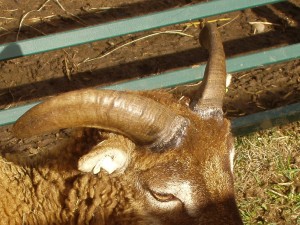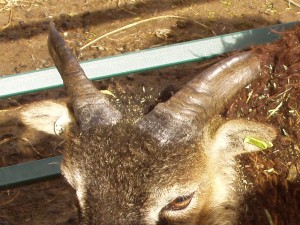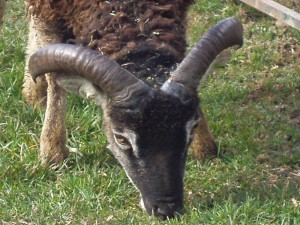Ram horn growth: another harbinger of spring
When last we met to discuss signs of spring, the topic was chicken eggs. It’s about time to re-direct attention to Soay sheep, don’t you think?
Every year along about January or early February, our previous spring’s ram lambs — what I refer to loosely as our “yearlings” — begin an impressive growth spurt which by the end of summer will take them nearly to their final adult size and shape. In addition to their overall body size, I am thinking in terms of two male anatomies, only one of which, their horns, can I discuss in this family-oriented blog. The Principal Scientist here at Saltmarsh Ranch tells me growth hormone is behind the overall increase in body size, but the presence of adequate levels of testosterone is required for horn elongation. The timing intrigues us. Just like everything else, these little guys hunkered down in the coldest, darkest days of winter in December and stopped growing. Even though nothing else seems to be growing in January and February, now that the days are longer, brighter and warmer, something remarkable has been triggered in the yearling rams’ physiologies.
Our trusty veterinary medicine tomes and sheep husbandry books occasionally remark on the circumstance that horn growth is correlated with length of days. And so I assume (and am trying to track this down with an outside expert), once the winter solstice has happened in late December, the combination of increased daylight, hormones, and perhaps melatonin, produces the surge in horn growth.
It is now the third week of February and we have just finished a 2-week stint of 55-60 degree weather, sunny, very little rain, a beautiful spring teaser. And let me tell you, our little guys’ horns are fairly popping out of their heads. I love watching them in their pasture, so full of themselves, strutting their stuff, playing pretend-head-butting, and generally looking like a fraternity pledge class parading in front of the sorority house. Sadly for them, the pregnant ewes in the adjacent pasture could not be less interested.
Yearling rams continue to experience horn elongation each late winter/early spring, but the spike in their first full spring is the most dramatic. Let me show you a few examples.
How to interpret the photos: new growth occurs at the base of the horn, right next to the skull. That is all you need to know to see what is going on. These photos were taken on February 20, 2008, towards the end of the horn growth period, and all are almost-yearling rams.
Here is Saltmarsh Grassington, a handsome little light phase British Soay sheep, son of Greener Pastures Jerry Lee Lewis and USA0001 Kiger, born April 10, 2007.
See the gnarly dark stuff on his horns right next to his head? That is his new growth. In other respects he still looks great and I am pleased to report that he is slated to breed one of these years. With the bright afternoon sunlight on his horns, you can really see the contrast between the old and the new. None of the new growth was visible in early January when last we made a mental note of it.
Saltmarsh Stillington, also a British Soay ram, son of Blue Mountain Warwick and Saltmarsh Keverne, was born a full month later, on May 11, 2007. His overall horn size is less than Grassington’s at this point, but the new horn growth on Stillington actually looks more substantial than Grassington’s. It could be the angle, and I am not of a mind to disturb the young fellows to do precise measurements.
Last but by no means least, Saltmarsh Eloy, an American Soay ram named for a town in Arizona, same sire as Stillington (Warwick) and his mother is Saltmarsh Nutmeg. Eloy was born about a week before Grassington, on April 5, 2007. Look at the horns on this little fellow!Eloy has about the same amount of new horn growth as Grassington, but perhaps because Eloy’s horns were darker to begin with, the contrast between the “older” part of his horns and his current growth spurt is not so great. Eloy sure looks like he will have Warwick’s wonderfully wide and stout horns, doesn’t he?
If I succeed in finding an authority who can explain the interplay of factors contributing to the unusually robust horn growth in January and February, I will share what I learn with you. Meanwhile, what I do know is that when we see our yearling rams start to put on their first burst of horn growth, spring — and lambing — is just around the corner.
For now . . .



Another sunny day and Spring comin’ on like a freight train for those of us in the country with many things to do! We look forward to news of the first lambs, and a chance to come enjoy their frolic.